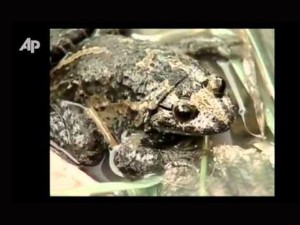Extinct frog declared ‘living fossil’ after being found ‘alive and well’

The Hula painted frog, The first amphibian to have been declared extinct by the world’s conservation watchdog has been named a “living fossil” after it was rediscovered alive and well in northern Israel, researchers reported on Tuesday, June 4, 2013. AP PHOTO
PARIS—The first amphibian to have been declared extinct by the world’s conservation watchdog has been named a “living fossil” after it was rediscovered alive and well in northern Israel, researchers reported on Tuesday.
In 1996, the International Union for Conservation of Nature (IUCN) put the Hula painted frog (Discoglossus nigriventer) in the same sad category as the dodo after its sole known habitat, Hula Lake in northern Israel, had been drained.
But Israeli, German and French researchers, writing in the journal Nature Communications, say that the white-spotted brownish frog is not only still around—it can also be classified, rather remarkably, as a “living fossil.”
In October 2011, a patrol in the nature reserve found an adult Hula painted frog close to a small pond, they reported.
’10 more specimens’
“Since then, we have recorded 10 more specimens (five males, one female and four juveniles) all within a restricted area of about 1.25 hectares (3.1 acres),” they said.
Seven were located in a mass of reeds and blackberry bushes, and three were collected after they had been taken by kingfisher birds.
The team then carried out a DNA test on the specimens, and compared the genome, body shape and bones against painted frogs from northern and western Africa.
To their surprise, D. nigriventer was found to be quite different from the other painted frogs.
In fact, it is the only surviving member of a clan (or species group) called the Latonia frogs. All its relatives died out in Europe about a million years ago, a few of which became preserved in fossilized form.
The Hula painted frog was first spotted in the early 1940s, when two adults and two tadpoles were found in the eastern part of the Hula Valley.
It was next sighted in 1955 during the drainage of the valley—and thereafter was not seen again.
“Not only has this species survived undetected in its type locality for almost 60 years, but also… it is a surviving member of an otherwise extinct genus,” said the paper.
“The survival of this living fossil is a striking example of resilience to severe habitat degradation during the past century by an amphibian.”
The frog’s chances of survival are being boosted by plans to reflood parts of the Hula Valley and restore the original swamp habitat.
The announcement is a rare bit of good news for amphibians.
Nearly a third of frog and toad species are described by the IUCN’s Red List as threatened by extinction. Habitat loss, the spread of pathogens by global warming and globalized trade and pollution are the main causes of the decline.
In 2010, conservationists reported that two African frog species, the Mount Nimba reed frog (Hyperolius nimbae) and the Omaniundu reed frog (Hyperolius sankuruensis), which had been feared extinct, had been spotted in Ivory Coast and the Democratic Republic of Congo respectively.